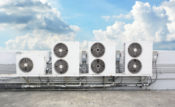 The HVACR industry is constantly changing whether it be through new technology advancements or mandatory phase outs on Ozone and high GWP refrigerants. The most extensive changes to HVAC/R regulations in 2 decades go into effect in less than 2 weeks. On January 1, 2019 big changes are coming to Section 608 of the Clean Air Act, the law that regulates stationary refrigeration practices.
The HVACR industry is constantly changing whether it be through new technology advancements or mandatory phase outs on Ozone and high GWP refrigerants. The most extensive changes to HVAC/R regulations in 2 decades go into effect in less than 2 weeks. On January 1, 2019 big changes are coming to Section 608 of the Clean Air Act, the law that regulates stationary refrigeration practices.
Originally when the leak rate changes were introduced they were thought to be applied to CFC, HCFC, and HFC refrigerants. While this is still the case today, the EPA did announce last month that they were considering removing the leak regulations on HFC refrigerants. This proposed rule was able to be commented on by the public and a ruling from the EPA is expected shortly. Until then, it’s safe to assume these changes to 608 are affecting both HFCs and CFC/HCFC refrigerants.
The 2019 changes will overhaul leak rate thresholds and the consequences for exceeding them. To avoid hefty fines and repercussions, detailed tracking, reporting and monitoring of refrigeration equipment will be required.
Here’s what you need to know about 2019 leak rate thresholds:
The new lower leak rate thresholds for all ozone-depleting substances and substitute cooling fluids are:
- 30% for industrial process refrigeration (previously 35%)
- 20% for commercial refrigeration (previously 35%)
- 10% for comfort cooling (previously 15%)
- 10% for other units (previously 15%)
If a commercial or industrial process refrigeration unit exceeds its leak rate threshold, it must be repaired and will be subject to the following series of inspections:
- Equipment with more than 500 lbs. of refrigerant requires quarterly inspections by a certified technician until the asset has remained below the leak rate threshold for four successive quarters.
- Equipment with 50 to 500 lbs. of refrigerant requires annual inspections by a certified technician until the asset has remained below the leak rate threshold for one year.
If a comfort cooling unit exceeds its leak rate threshold, it must be repaired and will be subject to the following series of inspections:
- If a comfort cooling unit with 50 or more lbs. of refrigerant exceeds its leak rate threshold, following repair, it must be inspected annually by a certified technician until the leak rate has remained below 10% for one year.
Staying Compliant
The equipment owner is required to provide specific documentation on servicing, leak rates, repairs and more for units that exceed their threshold. In addition to regular inspections, the equipment owner must demonstrate through leak rate calculations that the unit has been successfully repaired. Leak rates must be calculated initially with a verification test before refrigerant is added, as well as once the unit has returned to normal operating conditions.
The fines associated with violating any Section 608 rule can total $37,500 per day, plus expensive repair and replacement costs.
The best way to remain compliant with Section 608 is to use an HVAC service management software. With the stringency of the new requirements, calculating and reporting on paper or using a hodgepodge of disparate software products could leave you vulnerable to serious consequences.
FIELDBOSS stays current on industry trends to keep you informed on what’s happening in the HVACR world. Read our blog and sign up for our newsletter for all the latest news.
#608 #CleanAirAct #EPA #HFCRefrigerants